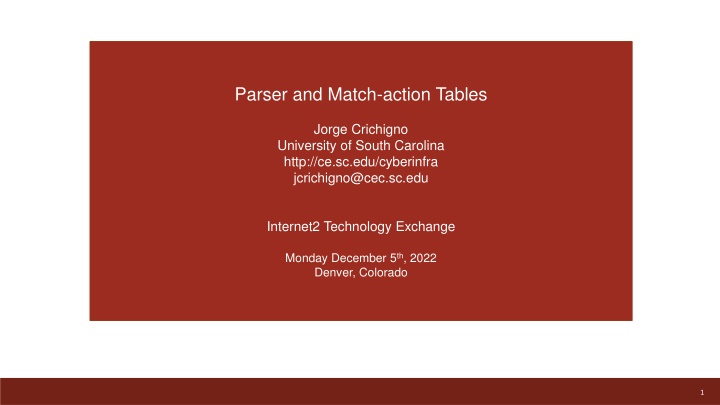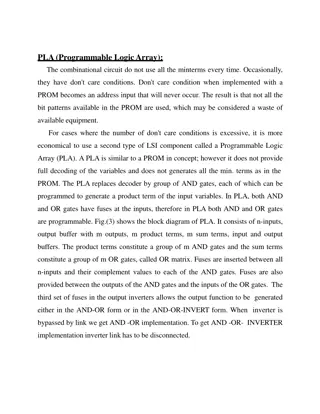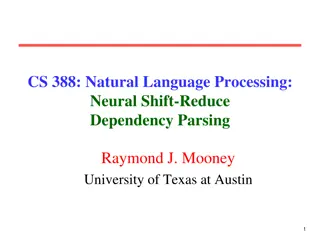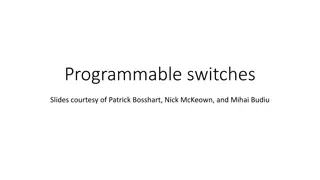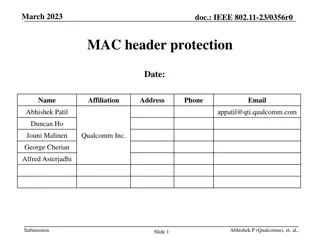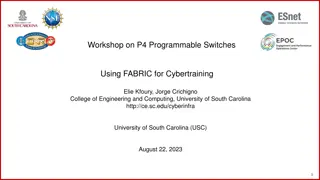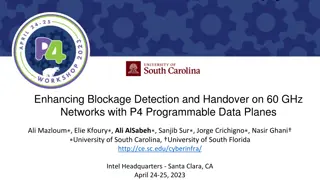Programmable Parser and Header Definitions at University of South Carolina
Programmable parsers and custom header definitions play a crucial role in network packet processing. This presentation by Jorge Crichigno at the University of South Carolina covers topics such as parser operation, predefined states, and header formats. The content delves into the capabilities of programmable parsers, including the ability to define arbitrary headers and customize packet parsing. Details on P416 methods for header extraction and branching within a parser are also discussed.
Download Presentation

Please find below an Image/Link to download the presentation.
The content on the website is provided AS IS for your information and personal use only. It may not be sold, licensed, or shared on other websites without obtaining consent from the author.If you encounter any issues during the download, it is possible that the publisher has removed the file from their server.
You are allowed to download the files provided on this website for personal or commercial use, subject to the condition that they are used lawfully. All files are the property of their respective owners.
The content on the website is provided AS IS for your information and personal use only. It may not be sold, licensed, or shared on other websites without obtaining consent from the author.
E N D
Presentation Transcript
Parser and Match-action Tables Jorge Crichigno University of South Carolina http://ce.sc.edu/cyberinfra jcrichigno@cec.sc.edu Internet2 Technology Exchange Monday December 5th, 2022 Denver, Colorado 1
Parser 2
Programmable Parser The parser enables parsing arbitrary headers with a finite state machine The state machine follows the order of the headers within the packets The packet is split into the defined headers and the remaining is treated as the payload 3
Packet Headers The packet headers are specified by the programmer The programmer has the flexibility of defining custom/non-standardized headers Such capability is not available in non-programmable devices Bit 0 0 1 2 3 4 5 IHL 6 7 8 9 10 11 12 13 14 15 16 17 DSCP 18 19 20 21 22 23 24 25 26 Total Length 27 28 29 30 31 Version ECN 32 Identifier Flags Fragment Offset 64 Time To Live Header Checksum Protocol 96 Source IP Address 128 Destination IP Address 160 Options (if IHL > 5) 4
Programmable Parser Every parser has three predefined states: start, accept, and reject Other states may be defined by the programmer In each state, the parser executes statements and then transitions to another state packet is an input parameter; hdr is an output parameter 5
Programmable Parser P416 has an extract method that can be used to fillin the fields of a header from the raw packet packet is an input parameter; hdr is an output parameter 6
Programmable Parser P416 has a select statement that can be used to branch in a parser packet is an input parameter; hdr is an output parameter 7
Headers Format Ethernet header: IPv4 header: IPv6 header: 8
Lab 4 Topology and Objectives The topology consists of two hosts: h1 and h2; one P4 switch: s1 The objectives are: Defining the headers for Ethernet, IPv4 and IPv6 Implementing the parser Testing and verifying the switch behavior when IPv4 and IPv6 packets are received s1-eth1 s1-eth0 0 1 9
Match-action Pipeline Tables are the fundamental unit of a Match-Action Pipeline; they define the processing logic inside the match-action pipeline They can be used to implement traditional switch tables (e.g., routing, flow lookup, access-control lists) They can implement custom user-defined complex logic Tables are implemented here Tables are implemented here 11
Match-action Table Specifies what data to match on Specifies a list of possible actions Optionally specifies a number of table properties; e.g., Size Default action Static entries An entry contains A specific key to match on An action that is executed when a packet matches the entry Action data (possibly empty) 12
Match-action Table Control plane Populate Match-action Table Key Action ID Action Data 13
Match-action Table Control plane Populate Key Match-action Table Key Action ID Action Data Headers and metadata 14
Match-action Table Control plane Headers and metadata Populate Key Match-action Table Hit Key Action ID Action Data ID Action code Hit/miss selector Data Default action Default action data Headers and metadata Metadata is intermediate data generated during execution of a P4 program 15
Match-action Table Metadata is intermediate data generated during execution of a P4 program Standard metadata - data that must be provided by targets ingress_port: port on which the packet arrived egress_spec: port to which the packet should be sent to egress_port: port on which the packet is departing from (read only in egress pipeline; useful value on ingress pipeline only) V1 model standard metadata 16
Example: IPv4 Forwarding Control plane Populate Match-action Table: ipv4_forwarding_table Key Action ID Action Data (dest IP) 192.168.0.1 ip_forward eg_port=4 10.0.0.5 ip_forward eg_port=1 17
Example: IPv4 Forwarding Control plane Populate dest IP Key Match-action Table: ipv4_forwarding_table Key Action ID Action Data (dest IP) 192.168.0.1 ip_forward eg_port=4 10.0.0.5 ip_forward eg_port=1 Headers and metadata 18
Example: IPv4 Forwarding Control plane Headers and metadata Populate dest IP Key Match-action Table: ipv4_forwarding_table Key Hit Action ID Action Data (dest IP) ip_forward 192.168.0.1 ip_forward eg_port=4 Action Code 10.0.0.5 ip_forward eg_port=1 egress_port = 4 Hit/miss selector TTL = TTL - 1 eg_port=4 Default action: drop Default action data: N/A Headers and metadata 19
Controls Similar to C functions (without loops) Can declare tables, variables Functionality specified by code in apply statement Swap source and destination MAC addresses Bounce the packet back out on the physical port that it came into the switch on 20
Actions Similar to C functions Can be declared inside a control or globally Parameters have type and direction Swap source and destination MAC addresses Bounce the packet back out on the physical port that it came into the switch on 21
Lab 5 Topology and Objectives The topology consists of two hosts: h1 and h2; one P4 switch: s1 The objectives are Implementing a table that matches on the destination IP address in the packet headers using the exact match Assigning the output port based on the matched IP address 22
